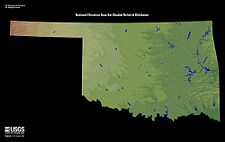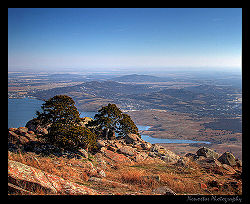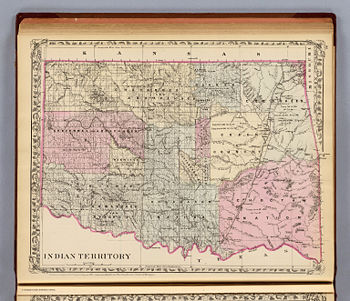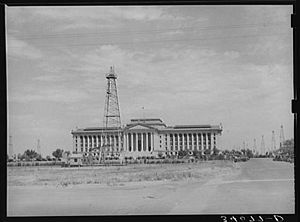Oklahoma (U.S. state): Difference between revisions
Pat Palmer (talk | contribs) |
Pat Palmer (talk | contribs) m (Text replacement - "Tom Coburn" to "Tom Coburn") |
||
| (10 intermediate revisions by the same user not shown) | |||
| Line 1: | Line 1: | ||
{{subpages}} | {{subpages}} | ||
{{TOC|right}} | |||
{{dambigbox|Oklahoma (U.S. state)|Oklahoma}} | |||
[[image:Oklahoma_flag.png|200px|thumb|Flag of the State of Oklahoma]] | [[image:Oklahoma_flag.png|200px|thumb|Flag of the State of Oklahoma]] | ||
'''Oklahoma''' is the 46th state admitted to the [[United States of America]] in 1907. It is nicknamed the "Sooner State", in reference to settlers who staked their claims prior to the official opening of the territorial land runs of the 1890's. The state name means "red people" which is a combination of the Choctaw words "ukla" and "humá".<ref>{{cite web | '''Oklahoma''' is the 46th state admitted to the [[United States of America]] in 1907. It is nicknamed the "Sooner State", in reference to settlers who staked their claims prior to the official opening of the territorial land runs of the 1890's. The state name means "red people" which is a combination of the Choctaw words "ukla" and "humá".<ref>{{cite web | ||
| Line 6: | Line 8: | ||
|accessdate=2008-01-21 | |accessdate=2008-01-21 | ||
}}</ref> | }}</ref> | ||
Oklahoma is the 20th largest state in land area at approximately 69,900 square miles. The capital and largest city is [[Oklahoma City, Oklahoma|Oklahoma City]], with other major cities including [[Tulsa, Oklahoma|Tulsa]] and [[Norman, Oklahoma|Norman]]. Oklahoma is bordered by [[Texas]] and [[New Mexico]] to the south and west, [[Kansas]] and [[Colorado (U.S. state)|Colorado]] to the north, and [[Missouri]] and [[Arkansas (U.S. state)]] to the east. | Oklahoma is the 20th largest state in land area at approximately 69,900 square miles. The capital and largest city is [[Oklahoma City, Oklahoma|Oklahoma City]], with other major cities including [[Tulsa, Oklahoma|Tulsa]] and [[Norman, Oklahoma|Norman]]. Oklahoma is bordered by [[Texas (U.S. state)|Texas]] and [[New Mexico (U.S. state)|New Mexico]] to the south and west, [[Kansas (U.S. state)|Kansas]] and [[Colorado (U.S. state)|Colorado]] to the north, and [[Missouri (U.S. state)|Missouri]] and [[Arkansas (U.S. state)]] to the east. | ||
{{Image|Oklahoma.jpg|right|225px|USGS shaded relief map of Oklahoma}} | {{Image|Oklahoma.jpg|right|225px|USGS shaded relief map of Oklahoma}} | ||
| Line 17: | Line 17: | ||
Oklahoma is part of the [[Mississippi River]] [[drainage basin]], with its primary rivers being the [[Arkansas River]], [[Canadian River]], and the [[Red River]]. | Oklahoma is part of the [[Mississippi River]] [[drainage basin]], with its primary rivers being the [[Arkansas River]], [[Canadian River]], and the [[Red River]]. | ||
===Climate=== | ===Climate=== | ||
Oklahoma has a [[continental climate]], experiencing long, hot summers and shorter, more mild winters. The weather is frequently affected by the warm, moist air masses moving north from the [[Gulf of Mexico]]. The mean annual temperature for the entire state is around 60ºF. There is a wide variation of precipitation between the eastern and western halves of the state, from 17" annually in the panhandle to 56" annually in the southeast.<ref>{{cite web | Oklahoma has a [[continental climate]], experiencing long, hot summers and shorter, more mild winters. The weather is frequently affected by the warm, moist air masses moving north from the [[Gulf of Mexico]]. The mean annual temperature for the entire state is around 60ºF. There is a wide variation of precipitation between the eastern and western halves of the state, from 17" annually in the panhandle to 56" annually in the southeast.<ref>{{cite web | ||
|url=http://cig.mesonet.org/climateatlas/doc60.html | |url=http://cig.mesonet.org/climateatlas/doc60.html | ||
| Line 28: | Line 28: | ||
|accessdate=2009-03-7 | |accessdate=2009-03-7 | ||
}}</ref>,is located in a geographical region known as [[Tornado Alley]]. | }}</ref>,is located in a geographical region known as [[Tornado Alley]]. | ||
==Geography== | ==Geography== | ||
| Line 70: | Line 66: | ||
The combination of the [[Great Depression]] and the [[Dust Bowl]] put an end to economic prosperity in the 1930s. Farmers were hit the hardest and many relocated to the cities and established poor communities known as [[Hoovervilles]]. It also initiated a mass migration of "Okies" to [[California (U.S. state)]] in search of a better life, an image that would be popularized in American culture by [[John Steinbeck]]'s novel, ''[[The Grapes of Wrath]]''. The economy did not recover until [[World War II]], when Governor [[Robert S. Kerr]] utilized friendships in Washington to secure federal money to help the state recover. Oklahoma built and expanded numerous army and navy installations and air bases, which in turn brought thousands of jobs to out of work citizens. By the 1950's Oklahoma had emerged from its economic woes. | The combination of the [[Great Depression]] and the [[Dust Bowl]] put an end to economic prosperity in the 1930s. Farmers were hit the hardest and many relocated to the cities and established poor communities known as [[Hoovervilles]]. It also initiated a mass migration of "Okies" to [[California (U.S. state)]] in search of a better life, an image that would be popularized in American culture by [[John Steinbeck]]'s novel, ''[[The Grapes of Wrath]]''. The economy did not recover until [[World War II]], when Governor [[Robert S. Kerr]] utilized friendships in Washington to secure federal money to help the state recover. Oklahoma built and expanded numerous army and navy installations and air bases, which in turn brought thousands of jobs to out of work citizens. By the 1950's Oklahoma had emerged from its economic woes. | ||
On April 19, 1995, Oklahoma experienced what at the time was the largest [[terrorism|terrorist]] attack on American soil. The [[Oklahoma City bombing]] occurred when | On April 19, 1995, Oklahoma experienced what at the time was the largest [[terrorism|terrorist]] attack on American soil. The [[Oklahoma City bombing]] occurred when an ammonium nitrate fertilizer bomb was detonated in front of the Alfred P. Murrah Federal Building in downtown Oklahoma City. The explosion, described by is perpetrator as retaliation against the federal government for their siege on the [[Branch-Davidian]] compound in Waco, Texas, killed 168 people. | ||
==Politics== | ==Politics== | ||
Oklahoma is a [[American conservatism|conservative]] state that is a [[ | Oklahoma is a [[American conservatism|conservative]] state that is a [[Republican Party (United States)|Republican]] stronghold in presidential elections, while splitting the vote in state and local elections. The two U.S. senators are Tom Coburn (R) and [[Jim Inhofe]] (R). After losing one seat following the 2000 Census, Oklahoma now has five representatives; four Republicans and one Democrat. | ||
[[Brad Henry]] (D) has been governor of Oklahoma since 2003. The Republicans control both the Oklahoma House of Representatives (61 to 40) and the Senate (26 to 22). | [[Brad Henry]] (D) has been governor of Oklahoma since 2003. The Republicans control both the Oklahoma House of Representatives (61 to 40) and the Senate (26 to 22). | ||
| Line 126: | Line 122: | ||
|accessdate=03-20-2009 | |accessdate=03-20-2009 | ||
}}</ref> | }}</ref> | ||
==See also== | |||
[[United States of America/Catalogs/States and Territories|U.S. States and Territories]] | |||
====Notes==== | ====Notes==== | ||
<references/> | <references/> | ||
Revision as of 15:05, 15 April 2024
Oklahoma is the 46th state admitted to the United States of America in 1907. It is nicknamed the "Sooner State", in reference to settlers who staked their claims prior to the official opening of the territorial land runs of the 1890's. The state name means "red people" which is a combination of the Choctaw words "ukla" and "humá".[1] Oklahoma is the 20th largest state in land area at approximately 69,900 square miles. The capital and largest city is Oklahoma City, with other major cities including Tulsa and Norman. Oklahoma is bordered by Texas and New Mexico to the south and west, Kansas and Colorado to the north, and Missouri and Arkansas (U.S. state) to the east.
The majority of the landscape is rolling plains, with scattered regions of hills and older mountain ranges. Its highest point is 4,973 feet above sea level at Black Mesa in Cimarron County, with the low point being 287 feet at the Little River in southeastern Oklahoma.
Rivers and drainage, lakes
Oklahoma is part of the Mississippi River drainage basin, with its primary rivers being the Arkansas River, Canadian River, and the Red River.
Climate
Oklahoma has a continental climate, experiencing long, hot summers and shorter, more mild winters. The weather is frequently affected by the warm, moist air masses moving north from the Gulf of Mexico. The mean annual temperature for the entire state is around 60ºF. There is a wide variation of precipitation between the eastern and western halves of the state, from 17" annually in the panhandle to 56" annually in the southeast.[2] Oklahoma, which has experienced 3,154 tornadoes between 1950-2008[3],is located in a geographical region known as Tornado Alley.
Geography
Oklahoma has a diverse landscape and is divided into 10 distinct regions:[4]
- Ozark Plateau
- Prairie Plains
- Ouachita Mountains
- Sandstone Hills
- Arbuckle Mountains
- Wichita Mountains
- Red River Valley
- Red Bed Plains
- Gypsum Hills
- High Plains
History
Prior to the area being discovered by Europeans, Oklahoma was occupied by a civilization noted for building mounds of earth across the landscape. The most notable archaeological evidence of this are the Spiro Mounds, located in eastern Oklahoma, which yielded artifacts dating between 850 and 1450 AD.[5] It is unknown if the Spiro peoples had any interaction with the European explorers, beginning with Coronado's expedition in 1541. Spanish explorers would continue to explore the area for the fabled Seven Cities of Cibola until they were challenged by the French in the late seventeenth century. In 1803, the territory that would become Oklahoma was sold by the United States as part of the Louisiana Purchase.
Around 1820, the federal government started using Oklahoma as a destination for Native American tribes being relocated from the east coast. Known as Indian Territory, the area became the new home of more than sixty tribes. The largest groups to be resettled were known as the Five Civilized Tribes (Cherokee, Choctaw, Chickasaw, Creek, and Seminole). Although some of the tribes signed removal treaties, the voluntary nature of them made the relocation a slow process. In 1830, the Indian Removal Act was passed, which granted the federal government greater authority to forcibly remove the tribes to their new territory. Exposed to disease, lack of supplies, and military pressure, there was great suffering among the tribes during their removal and their ordeal is referred to as the Trail of Tears.
At the outbreak of the Civil War in 1861, federal troops abandoned Indian Territory and headed east. The Confederacy, recognizing the Union would likely block their major ports, desired to utilize the territory to bolster their food supply. The Confederacy sent Arkansas attorney Albert Pike to negotiate treaties with the Five Civilized Tribes. The tribes were slaveholders, which aligned them ideologically with the South. Pike promised to pay the subsidies the U.S. government had paid, permanently guarantee their lands and their right to tribal self-government, and to provide protection and guns. Only with their consent could they be sent outside the territory to do battle. The Cherokees and Choctaws could send a delegate to the Confederate Congress, with the prospect of eventually become a state.[6]
While these promises allowed the Confederacy to secure alliances with a majority of the tribes, a minority desired to remain neutral, which led to violent conflict with the Confederate Indians. The first Civil War battle in Indian Territory occurred at Round Mountain, in which the Confederates defeated a group of loyalist Creek and Seminoles led by Opothleyahola. The Confederates dominated the territory until early 1862 when Union troops returned and won battles at Pea Ridge, Fort Gibson, and Honey Springs. The Confederate Indians were the last to surrender, three months after Robert E. Lee surrendered at Appomattox Courthouse.[7]
Going to war against the United States proved to be the downfall of Indian independence. The Five Tribes were punished and forced to cede their lands in western Oklahoma to new tribes that were moved in, including the Arapahoe, Kiowa, Apache, Wichita, Caddo and Osage. By 1885, 45 new tribes had relocated to Indian Territory. The new treaties granted the railroads the right to lay track across Indian Territory and by 1905, 5,231 miles of track had been laid.[8] While bringing new economic opportunities, it also led to an influx of white settlers which made the Indians minorities in their own land and threatened the control of the tribal governments. Hunters slaughtered the buffalo herds, a primary food source of the Indians. Crime and lawlessness became rampant. The tribes appealed to the federal government for help, which was granted in 1871 with the establishment of a federal court to deal with issues in the territory. This new court usurped the power of less powerful Indian courts. The Dawes Act of 1887 gave Indians title to land individually (rather than tribally), and they started to sell it off.
By the 1880's many Americans were looking for a new start and sought to use the Homestead Act as the legal right to settle the unassigned lands in Oklahoma. The federal government unsuccessfully attempted to disallow this. Eventually the government relented and the Land Run of 1889 opened the lands of Oklahoma to white settlement on April 22, 1889. Over 50,000 homesteaders arrived and at noon raced to claim 160 acre homesteads. Those settlers who made an illegal head start were called "sooners".[9] Slowly more reservations were opened up for white settlement and the area became known as Oklahoma Territory and a territorial government was formed by the Oklahoma Organic Act of 1890. Cities sprang up overnight, including Oklahoma City, Stillwater, Kingfisher, Edmond, and Guthrie. Guthrie became the new capital of Oklahoma Territory, in the west, with Indian Territory in the east. The combined population reached 1 million, but they resisted being joined together and desired to be admitted to the United States as separate states. Indian Territory had even gone to the lengths of creating a constitution to form a new state named Sequoyah. The Roosevelt administration had no desire to see this happen, as he was a Republican and Indian Territory would have almost certainly been a Democratic stronghold. The Oklahoma Enabling Act of 1906 was passed by Congress which authorized a constitutional convention, which met in Guthrie, to merge the two territories. In spite of this, the convention and early government was dominated by Democrats. The State of Oklahoma was officially admitted to the Union on November 16, 1907, with a democratic constitution that prohibited liquor, established Jim Crow laws, provided for the initiative and referendum, created strong county governments, regulated railroad rates, and limited the governor to one elected term. The Republican-dominated Guthrie remained the state capital until 1910 when it moved to a largely Democratic Oklahoma City.
The early years of statehood were marked with political activity. In 1910, the Democrats moved the capital to Oklahoma City, three years before the Oklahoma Organic Act allowed, in order to move away from the Republican hotbed of Guthrie. Socialism became a growing force among struggling farmers, and Oklahoma grew to have the largest Socialist population in the United States at the time, with the Socialist vote doubling in every election until the outbreak of World War I in 1914.[10]. However, the war drove food prices up, allowing the farmers to prosper, and the movement faded away. By the 1920's, the Republican Party, taking advantage of rifts within the Democratic Party, gained control in the state. The economy continued to improve,in the areas of cattle ranching, cotton, wheat, and especially, oil. Throughout the 1920's, new oil fields were continually discovered and Oklahoma produced over 1.8 billion barrels of petroleum, valued at over 3.5 million dollars for the decade.[11]
The combination of the Great Depression and the Dust Bowl put an end to economic prosperity in the 1930s. Farmers were hit the hardest and many relocated to the cities and established poor communities known as Hoovervilles. It also initiated a mass migration of "Okies" to California (U.S. state) in search of a better life, an image that would be popularized in American culture by John Steinbeck's novel, The Grapes of Wrath. The economy did not recover until World War II, when Governor Robert S. Kerr utilized friendships in Washington to secure federal money to help the state recover. Oklahoma built and expanded numerous army and navy installations and air bases, which in turn brought thousands of jobs to out of work citizens. By the 1950's Oklahoma had emerged from its economic woes.
On April 19, 1995, Oklahoma experienced what at the time was the largest terrorist attack on American soil. The Oklahoma City bombing occurred when an ammonium nitrate fertilizer bomb was detonated in front of the Alfred P. Murrah Federal Building in downtown Oklahoma City. The explosion, described by is perpetrator as retaliation against the federal government for their siege on the Branch-Davidian compound in Waco, Texas, killed 168 people.
Politics
Oklahoma is a conservative state that is a Republican stronghold in presidential elections, while splitting the vote in state and local elections. The two U.S. senators are Tom Coburn (R) and Jim Inhofe (R). After losing one seat following the 2000 Census, Oklahoma now has five representatives; four Republicans and one Democrat.
Brad Henry (D) has been governor of Oklahoma since 2003. The Republicans control both the Oklahoma House of Representatives (61 to 40) and the Senate (26 to 22).
Culture
The most famous personality was Will Rogers, a celebrity and humorist of the 1920s.
Music
Oklahoma has a rich musical heritage in numerous genres. Western swing originated in Oklahoma and was popularized by Bob Wills and the Texas Playboys playing at historic Cain's Ballroom in Tulsa. Oklahoma has also produced a great number of country musicians, including Garth Brooks, Reba McEntire, Vince Gill, Toby Keith, and Carrie Underwood. It also produced Depression-era folk singer-composer Woody Guthrie and popular modern rock acts such as The Flaming Lips and the All-American Rejects.
It was also the subject of the Rodgers and Hammerstein musical Oklahoma!, based on a novel of Oklahoma's pioneer days. The title song was adopted as the official state song in 1953.[12]
Sports
The sports scene in Oklahoma is dominated by collegiate athletics. Arguably the most popular is the University of Oklahoma Sooners football team, which has won seven national championships. There is also a large following of the Oklahoma State University men's basketball program, which has won two national championships. Both universities are also perennial powerhouses in wrestling, baseball, and golf.
The state entered into the professional sports arena in 2005 following Hurricane Katrina when it became the temporary home for the National Basketball Association's New Orleans Hornets for two years. Following the 2007, the team relocated back to New Orleans but fan support for the team brought Oklahoma City into the national spotlight as a city that was capable of supporting a professional basketball team. This led a group of local businessmen to purchase the Seattle SuperSonics in 2006, with hopes of permanently relocating the team to Oklahoma City. The team was officially relocated to Oklahoma City prior to the 2008-2009 season and changed it's name to the Oklahoma City Thunder.
Education
Oklahoma has 12 public universities, with the most notable being the University of Oklahoma and Oklahoma State University. It is also home several prominent private institutions of higher education, such as Oral Roberts University and the University of Tulsa.
The public school system in Oklahoma ranks among the lowest in the nation in teacher salaries (ranked 42nd) and expenditure per student (ranked 46th). In terms of student enrollment, teacher-student ratio and other statistics, the state is roughly in the middle among the 50 states.[13] According to the Morgan Quitno Press, Oklahoma ranks 36th in educational quality in the United States.[14]
Demographics
Oklahoma's estimated population in 2007 was 3,617,316, experiencing a 4.8% growth since 2000, and having a population density of 50.3 persons per square mile.[15] The population is predominantly White(non-Hispanic) with 2,833,428 residents, followed by 286,849 Black, 285,764 American Indian, 261,635 Hispanic, 62,597 Asian, and 3,653 Hawaiian/Pacific Islander.[16]
Economy
Oklahoma's major industries are agriculture(primarily wheat and livestock), aerospace, manufacturing, and energy. A large portion of the workforce is employed in military and government jobs. It is home to 4 Fortune 500 companies, all of which are from the energy sector; Tulsa based ONEOK and Williams Companies, Inc., and Oklahoma City based Devon Energy and Chesapeake Energy.[17]
The unemployment rate as of January 2009 5%.[18]
See also
Notes
- ↑ State History Guide Resources. Retrieved on 2008-01-21.
- ↑ The Climate of Oklahoma by Derek Arndt, Climatologist, Oklahoma Climatological Survey, Norman, Oklahoma, January 1, 2003. Retrieved on 2008-01-19.
- ↑ National Weather Service - Monthly and Annual Tornado Statistics for the State of Oklahoma (1950 - 2009). Retrieved on 2009-03-7.
- ↑ See The Geography of Oklahoma. Retrieved: September 5, 2007
- ↑ Oklahoma Historical Society - Spiro Mounds Archaeological Park. Retrieved on 2008-01-07.
- ↑ Dale and Wardell, History of Oklahoma (1948) p. 164
- ↑ Baird and Goble, The Story of Oklahoma, (1994) p.179
- ↑ Baird and Goble, The Story of Oklahoma, (1994) p.191
- ↑ Edward Everett Dale and Morris L. Wardell, History of Oklahoma (1948), 249-250 explain their actions were highly illegal.
- ↑ Baird and Goble, The Story of Oklahoma, (1994) p. 346
- ↑ Baird and Goble, The Story of Oklahoma, (1994) p. 366
- ↑ Broadway - The American Musical: Oklahoma. Educational Broadcasting Corporation. 2004. PBS. Retrieved: September 5, 2007
- ↑ National Education Association 2008 Rankings and Estimates. Retrieved on 2009-03-7.
- ↑ Which State Is Smartest? 2006. Retrieved on 2009-03-7.
- ↑ Oklahoma QuickFacts from the US Census. Retrieved on 2009-03-7.
- ↑ Oklahoma Department of Commerce 2007 Population Estimates. Retrieved on 2009-03-7.
- ↑ 2008 Forbes Magazine Fortune 500 list. Retrieved on 2009-03-07.
- ↑ US Department of Labor. Retrieved on 03-20-2009.




